How to Travel to Vietnam from Poland : The Complete, Practical & Inspiring Guide
Planning a trip from Central Europe to Southeast Asia is always an exciting journey, and Vietnam has long been one of the favourite long-haul destinations for Polish travellers. Its harmonious blend of ancient traditions, stunning nature, dynamic cities, warm hospitality and delicious cuisine makes it a country that captures the imagination from the moment you arrive. However, before living your dream holiday, you may be asking an essential question: How to travel to Vietnam from Poland ?
This comprehensive guide provides everything you need: flights, visa, budget, itineraries, transport options, weather considerations, cultural tips and practical advice to ensure a smooth, memorable and comfortable trip.
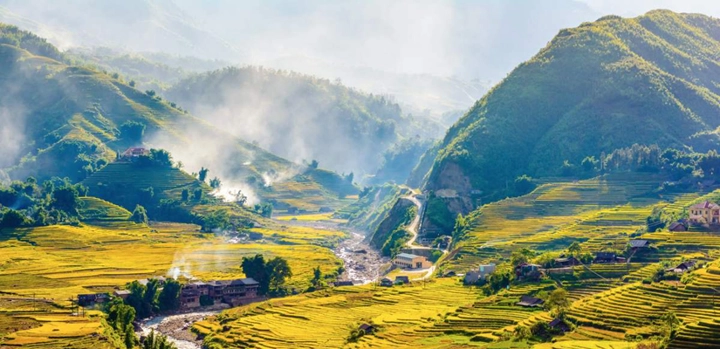
1. How to Travel to Vietnam from Poland ?
Vietnam and Poland are connected by several daily flight options, but no direct flight currently exists. Therefore, the core of the question How to travel to Vietnam from Poland ? starts with choosing the right transit hub. The most common and efficient connecting airports include: Doha (Qatar Airways), Dubai (Emirates), Abu Dhabi (Etihad Airways), Istanbul (Turkish Airlines), Frankfurt, Munich or Paris (Vietnam Airlines & European airlines) and Helsinki (Finnair seasonal routes)
Depending on your schedule, cabin preference and price expectations, each airline offers different advantages. Qatar Airways and Emirates usually provide the most convenient connections, with high-quality onboard service. Turkish Airlines is often the most competitive in terms of price. Vietnam Airlines, when flying through European hubs, ensures a smooth transition for travellers who prefer a national carrier.
Understanding these links is a crucial first step in answering How to travel to Vietnam from Poland ? efficiently and comfortably.
2. What Polish Travellers Must Know
Before answering in detail How to travel to Vietnam from Poland ?, it is essential to understand Vietnam’s entry and visa policy. Fortunately, Vietnam offers a simple and accessible e-Visa system for Polish citizens.
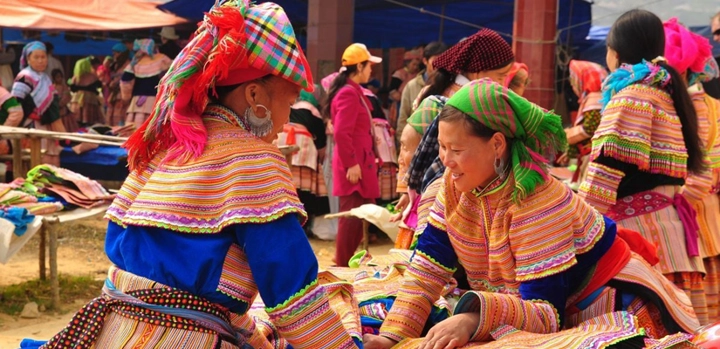
Vietnam e-Visa (recommended)
The Vietnam e-Visa is the most convenient option for international travellers, offering a smooth, fully digital application process without the need to visit an embassy. It is widely accepted across the country and ideal for both short leisure trips and longer journeys.
Valid for 30 or 90 days, single or multiple entry
Travellers can choose between a 30-day or 90-day validity period depending on the length of their stay. The e-Visa is available in both single-entry and multiple-entry formats, providing flexibility for those planning to explore neighbouring countries before returning to Vietnam.
Apply entirely online
The application is completed 100% online, from uploading your passport photo and passport scan to making the payment. No in-person interviews or document submissions are required, making the process accessible to anyone with an internet connection.
Processing time: 3–5 working days (sometimes 7 days in busy periods)
Standard processing usually takes 3 to 5 working days, though it can extend to around 7 days during peak travel seasons or holidays. Travellers are advised to apply well in advance, especially for trips planned around Vietnamese national festivals or long weekends.
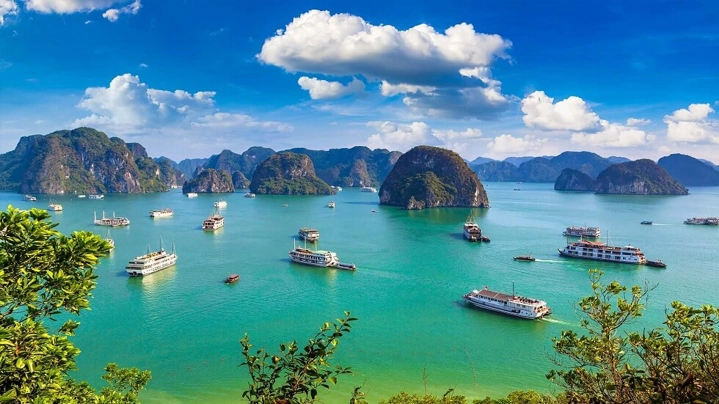
Cost: varies from USD 25 to 50 depending on entry type
The application fee ranges from USD 25 to USD 50, depending on whether you choose a single-entry or multiple-entry visa. This fee is paid online during the application and is non-refundable, even in cases of refusal.
Accepted at airports, sea ports and land borders
Once approved, the e-Visa can be used at all major international airports, several seaports, and designated land border crossings throughout Vietnam. This makes it suitable for travellers arriving by air, cruise, or overland from neighbouring countries such as Cambodia, Laos or China.
For most travellers, obtaining an e-Visa is the fastest, most practical and safest option. It also allows greater flexibility when planning your route.
When asking How to travel to Vietnam from Poland ?, one should always consider applying for the e-Visa at least two weeks before departure to avoid last-minute delays.
Documents Required
Passport valid for at least 6 months from arrival date
Ensure that your passport remains valid for at least six months beyond the date you enter Vietnam. This requirement is strictly enforced at all international airports and land borders. A longer validity helps prevent complications during immigration procedures and guarantees that your visa whether electronic or stamped on arrival remains valid throughout your stay.
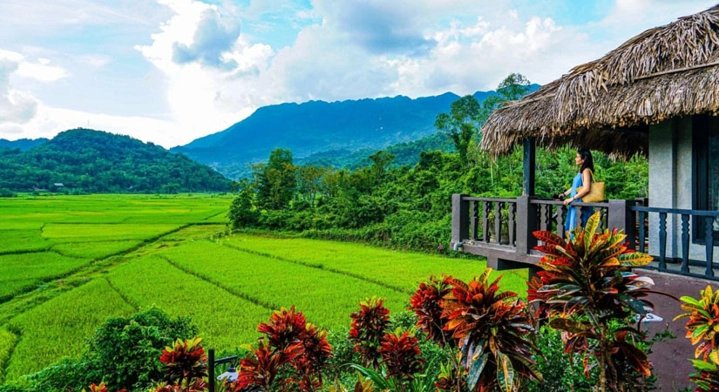
Personal photo (passport-size)
Prepare a recent passport-size photo that meets standard requirements: a clear, front-facing portrait with a plain background, neutral expression, and no headwear (unless worn for religious reasons). This photo is essential for visa applications such as the e-visa, visa on arrival, or certain administrative checks upon entering the country.
Digital copy of passport
Have a high-resolution digital scan of the information page of your passport. This copy is required when submitting an online visa application, and having it readily accessible during your trip on your phone or cloud storage is a smart precaution in case of loss or emergency.
Entry/exit dates and point of entry
You will need to indicate your planned arrival and departure dates, as well as the specific airport or border gate where you intend to enter Vietnam. These details must be accurate, as they determine the validity of your visa and ensure a smooth process upon arrival. Always double-check the spelling of the entry point and ensure your travel itinerary matches your visa information.
Having your visa approved before boarding your plane is a substantial part of ensuring a stress-free answer to the question How to travel to Vietnam from Poland ?.
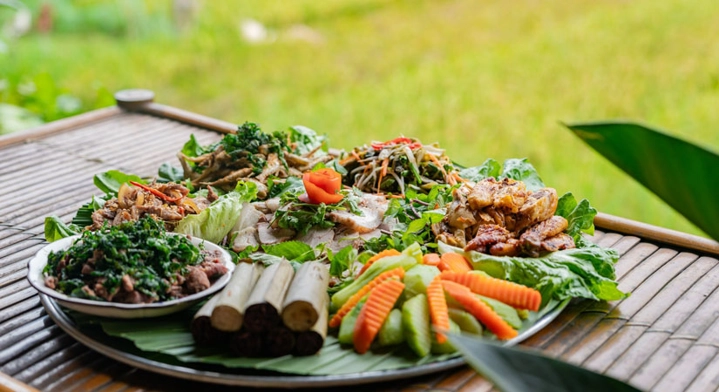
3. Best Time to Visit Vietnam
Vietnam extends more than 1,600 kilometers from north to south, creating a remarkable variety of climates. This means each region has its own “perfect moment” to visit. Understanding these seasonal contrasts is an essential part of planning How to travel to Vietnam from Poland ?, especially if you want to enjoy the best weather during your journey.
Northern Vietnam (Hanoi, Sapa, Hoang Su Phi, Ha Giang, Mai Chau, Pu Luong, Halong Bay)
Best months: October to April
Northern Vietnam experiences its most pleasant weather during the cooler, drier months. From autumn to spring, the skies are clearer, the humidity drops, and the landscapes shine in their full beauty.
Ideal for cultural exploration: Hanoi’s Old Quarter, ancient pagodas and museums are more enjoyable without summer heat.
Perfect trekking conditions: In Sapa, Hoang Su Phi, Ha Giang or Pu Luong, the fresh mountain air and stable weather create excellent conditions for hiking, photography and homestay experiences.
Best time for cruises: Halong Bay and Lan Ha Bay offer calm seas, soft sunlight and excellent visibility, making winter and spring the prime seasons for cruises.
These months highlight the authenticity and natural charm of the mountainous North.
Central Vietnam (Hue, Phong Nha Ke Bang, Da Nang, Hoi An)
Best months: February to August
Central Vietnam enjoys long, warm and sunny periods that are perfect for both cultural visits and seaside relaxation.
Long days of sunshine: From February onward, the weather becomes stable, ideal for discovering the Imperial City of Hue or exploring the caves in Phong Nha Ke Bang.
Perfect beach conditions: Da Nang and Hoi An offer inviting blue waters and soft sand, with excellent conditions for swimming, diving and relaxing.
Ideal for heritage lovers: The dry season brings comfortable temperatures for exploring ancient temples, old towns, and coastal villages without the interruption of heavy rain.
This period offers some of the finest weather in the entire country.
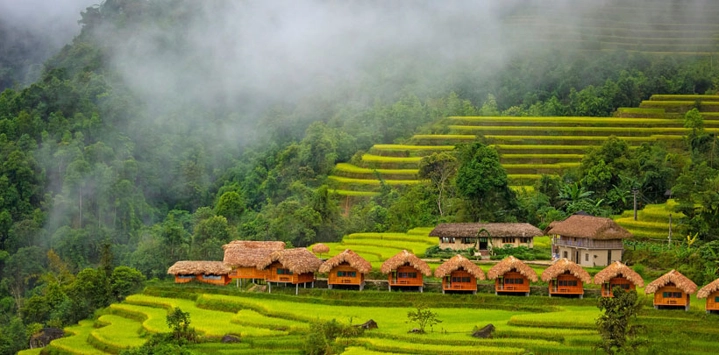
Southern Vietnam (Ho Chi Minh City, Mekong Delta, Phu Quoc)
Best months: December to April
Southern Vietnam follows a typical tropical climate with a clearly defined dry season. During these months, temperatures are warm but pleasant, and rainfall is minimal.
City exploration at its best: Ho Chi Minh City is vibrant and energetic, with comfortable conditions for walking tours, rooftop dining or museum visits.
Ideal for floating markets: In the Mekong Delta, the dry season makes boat excursions easier and more enjoyable, with lush landscapes and bustling waterways.
Beach paradise: Phu Quoc experiences its finest weather between December and April, offering calm seas, sunshine and ideal conditions for snorkeling, boat trips and relaxing on pristine beaches.
This is the most popular period for travellers seeking warmth and sunshine.
For travellers leaving Poland
Those departing Poland during the colder months often find Vietnam the perfect escape. While European winter brings frost and snow, Vietnam offers a mix of mild northern breezes, sunny beaches in the center, and tropical warmth in the south.
Considering the country’s seasons is essential when planning How to travel to Vietnam from Poland ? and choosing the best itinerary. With the right timing, you will enjoy Vietnam at its most beautiful whether you prefer culture, nature, adventure or simple relaxation under the sun.
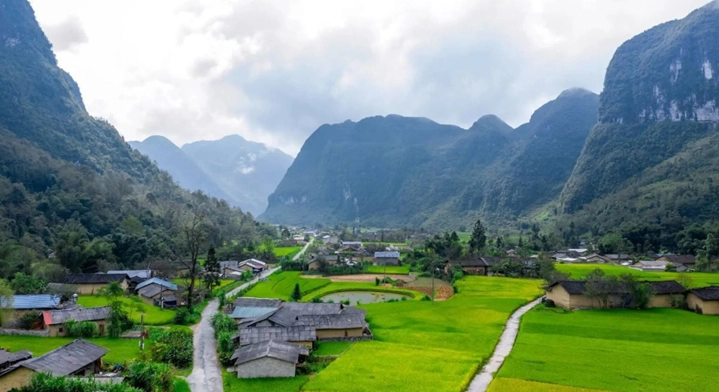
4. Flight Prices & Booking Tips
Understanding airfare and knowing how to optimise it is one of the most important aspects when exploring How to travel to Vietnam from Poland ?. Being aware of typical price ranges and the factors that influence them will help you plan a smoother and more economical journey.
Average Round-Trip Prices
Economy Class (2,500 – 4,000 PLN)
This is the most common choice for travellers. Fares in this range usually include one checked bag and a standard meal service. Prices on the lower end typically apply outside peak seasons or during airline promotions, while higher fares appear closer to major holidays or when booking late.
Premium Economy (5,000 – 8,000 PLN)
Premium economy offers more legroom, better seat recline, priority check-in and occasionally upgraded meals. These fares suit travellers looking for added comfort on long-haul flights without the high cost of business class.
Business Class (12,000 – 18,000 PLN)
Business class provides a superior experience with lie-flat seats, premium dining, lounge access and flexible tickets. The price varies based on demand, the chosen airline and the route (direct vs. multi-stop).
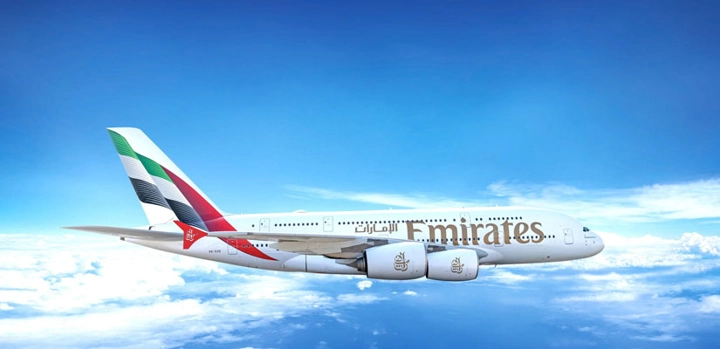
Prices vary depending on:
Travel Season
Christmas, New Year, Tết (Vietnamese Lunar New Year), and summer holidays are the most expensive periods. Demand peaks sharply, and fares increase weeks or even months before these dates.
Booking Period
The ideal booking window is generally 2–4 months in advance. Booking too early can be as expensive as booking too late, when only higher fare classes remain.
Airline & Route
Airlines such as Qatar Airways, Emirates, Turkish Airlines and LOT often offer competitive prices. Indirect routes through Istanbul, Doha or Dubai are usually cheaper than those requiring multiple connections.
Tips to Get the Best Deals
Travel Mid-Week
Flying on Tuesdays, Wednesdays or Thursdays often results in significantly lower fares compared to weekend departures or returns.
Avoid Polish School Holidays
Demand increases during winter and summer breaks, causing price spikes. Flexible travellers can save hundreds of złoty by travelling just a week before or after these periods.
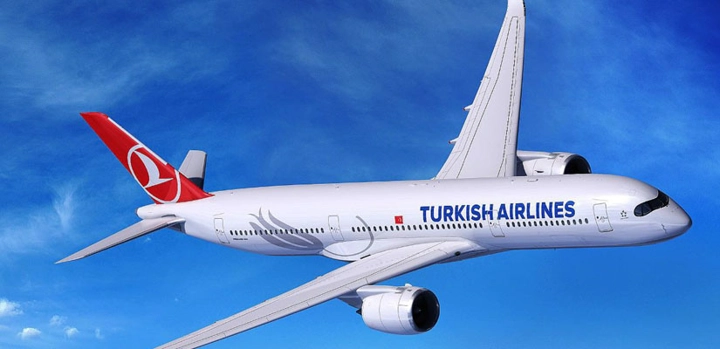
Compare Different Transit Routes
Connections via Istanbul (Turkish Airlines), Doha (Qatar Airways) or Dubai (Emirates) often offer the best balance between comfort, reliability and price.
Consider Open-Jaw Tickets
Flying into Hanoi (HAN) and departing from Ho Chi Minh City (SGN) (or vice versa) can reduce costs and optimise your itinerary in Vietnam, especially for north-to-south trips.
For many travellers, securing good airfare is a key part of planning How to travel to Vietnam from Poland ?. With smart timing, flexible travel dates and careful route comparison, you can significantly reduce your flight budget while still enjoying comfort and convenience throughout your journey.
If you'd like, I can now help you expand this into a full article, create the next section, or refine the structure.
5. Where to Land and Why
Vietnam has three major international gateways. Choosing the right one shapes your itinerary and helps refine your plan for How to travel to Vietnam from Poland ?.

1. Hanoi – Noi Bai Airport (HAN)
Hanoi – Noi Bai Airport (HAN) is the main gateway to the northern region of Vietnam, offering smooth connections to both the capital and the country’s most iconic landscapes. Efficient transport links, modern facilities and a strategic location make it the perfect starting point for discovering the diverse beauty of northern Vietnam. Ideal for exploring :
Halong Bay
From Noi Bai Airport, travellers can easily reach the legendary Halong Bay, a UNESCO World Heritage Site known for its limestone karsts rising from emerald waters. Whether you choose a day cruise or an overnight luxury junk, HAN is the most convenient arrival point for quick transfers to the port of Halong or Tuan Chau.
Sapa
Noi Bai Airport is the closest major hub to the misty mountains of Sapa. From Hanoi, the journey to Sapa leads you past terraced rice fields, ethnic minority villages and dramatic peaks. It’s ideal for travellers planning trekking, homestays or cultural immersion in Vietnam’s highlands.
Ninh Binh
Often called “Halong Bay on land,” Ninh Binh is easily accessible from Hanoi. Arriving at HAN allows you to travel smoothly to this peaceful region of karst mountains, rice fields, ancient temples and serene waterways such as Tam Coc and Trang An.
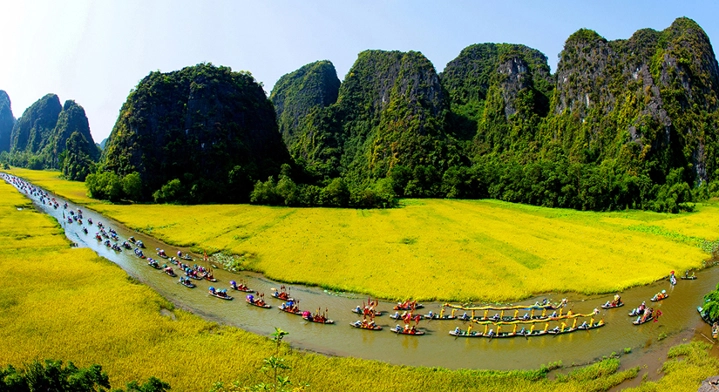
Ha Giang
For travellers heading toward the breathtaking Ha Giang Loop, Noi Bai Airport is the preferred entry point. From here, the road takes you through one of Vietnam’s most spectacular landscapes deep canyons, terraced fields and the legendary Ma Pi Leng Pass.
Mai Chau
HAN provides direct access to Mai Chau’s peaceful valley, where Thai ethnic villages, stilt houses and vibrant green rice paddies create a charming rural escape. It is perfect for travellers interested in cycling, easy hikes and cultural experiences.
Pu Luong
From Noi Bai Airport, you can quickly reach Pu Luong Nature Reserve, an untouched paradise of rice terraces, bamboo forests and tranquil villages. It’s an excellent destination for eco-travellers, trekkers and those seeking authentic countryside life.
Northern tea mountains
Arriving at HAN is ideal for journeys into Vietnam’s northern tea-growing regions such as Thai Nguyen, Moc Chau or Yen Bai. These areas offer rolling tea hills, cool climates and encounters with local farmers—perfect for travellers curious about traditional agriculture and scenic highland landscapes.
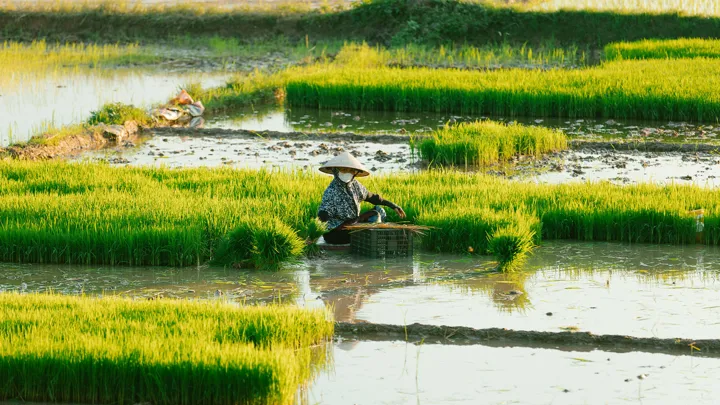
2. Ho Chi Minh City – Tan Son Nhat Airport (SGN)
Tan Son Nhat International Airport (SGN) is the main gateway to Southern Vietnam and the busiest airport in the country. Located just a short drive from the heart of Ho Chi Minh City, it offers excellent flight connections, modern services, and fast access to vibrant urban districts, cultural attractions, and major transport routes leading to the Mekong Delta and coastal regions.
Mekong Delta
Tan Son Nhat Airport is the most convenient entry point for exploring the Mekong Delta, a vast network of rivers, orchards, floating markets and peaceful rural landscapes. From Ho Chi Minh City, travellers can quickly reach the Delta by private car or bus and begin their journey through lush waterways, coconut groves, and authentic villages.
Ben Tre
Ben Tre, known as the “land of coconuts,” is easily accessible from SGN airport. Travellers arriving at Tan Son Nhat can reach Ben Tre in about 2–2.5 hours, making it an ideal choice for those seeking river cruises, biking routes through tropical gardens, and quiet homestays along palm-lined canals.
Tra Vinh
Tra Vinh, a culturally rich province with strong Khmer heritage, becomes much more accessible via Tan Son Nhat Airport. The drive from Ho Chi Minh City takes roughly 3–4 hours, offering visitors a smooth connection to ancient pagodas, traditional Khmer villages, and serene rice-field landscapes.
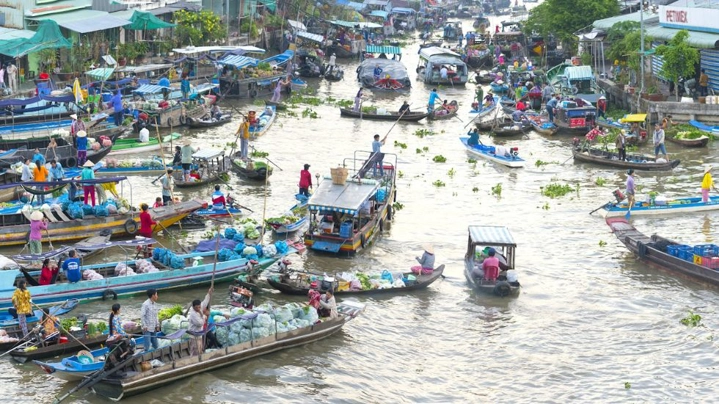
Can Tho
Tan Son Nhat Airport is the preferred arrival point for journeys to Can Tho, the Mekong Delta’s largest city. A comfortable 3.5–4-hour transfer brings travellers directly from SGN to famous highlights such as the Cai Rang floating market, waterfront promenades, vibrant night markets and lush countryside.
Phu Quoc Island
SGN offers the most frequent flights to Phu Quoc Island, making it the best departure point for travellers heading to Vietnam’s leading beach destination. Multiple daily flights connect Ho Chi Minh City to Phu Quoc, ensuring flexibility and smooth travel before you arrive on its white-sand beaches and crystal-clear waters.
Cu Chi Tunnels
The historic Cu Chi Tunnels are just 1.5–2 hours from Tan Son Nhat Airport. Travellers arriving in Ho Chi Minh City can easily organise a half-day or full-day trip to the underground tunnel system, learning about wartime history through immersive exhibits and guided experiences.
Southern beaches
Whether you’re heading to Vung Tau, Ho Tram, Mui Ne, or the islands of the South, Tan Son Nhat Airport provides the quickest and most efficient start. A variety of transfers, from private cars to buses and domestic flights, make SGN the ideal entry point for travellers looking to enjoy sun-drenched coastlines, water sports, seafood cuisine, and tranquil beach retreats.

3. Da Nang Airport (DAD)
Da Nang International Airport is the main gateway to Central Vietnam and one of the most efficient airports in the country. Located just a few minutes from the city center, it offers modern facilities, smooth arrivals, and excellent connections to nearby cultural and natural sites. Its strategic position makes it ideal for travellers who wish to explore the heritage-rich provinces of Quang Nam, Da Nang, and Thua Thien–Hue.
Hoi An
Hoi An lies about 30 minutes from Da Nang Airport and remains one of Vietnam’s most enchanting destinations. Its lantern-lit streets, ancient merchant houses, riverside cafés, and tailor shops create an atmosphere unlike anywhere else in the country. From DAD, travellers can quickly reach Hoi An’s UNESCO-listed Old Town, An Bang Beach, and the surrounding craft villages.
My Son Sanctuary
Around an hour from the airport, My Son Sanctuary offers a journey back in time to the Champa Kingdom. Hidden in a lush valley, this archaeological complex is home to ancient towers, refined sandstone sculptures, and a deep spiritual atmosphere. Landing at Da Nang makes reaching this UNESCO World Heritage Site simple and convenient for cultural enthusiasts.
Hue
Hue, the former imperial capital, is located around two hours north of Da Nang Airport via the breathtaking Hai Van Pass. Travellers arriving at DAD can easily visit the majestic Citadel, royal tombs, pagodas, and peaceful riverside landscapes. The airport’s proximity provides a practical entry point for those wishing to explore Central Vietnam’s most historic city.
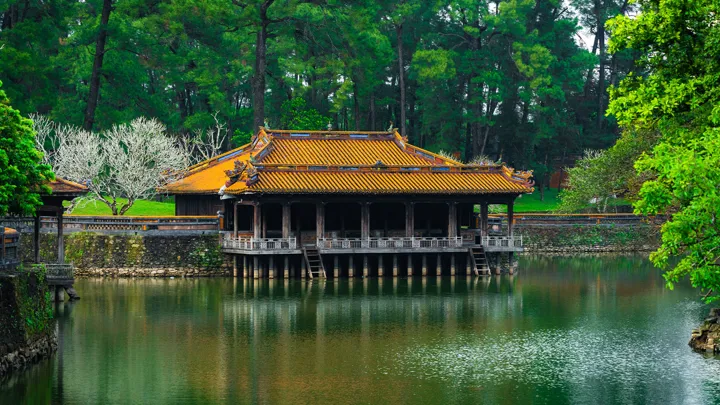
Phong Nha – Ke Bang
For travellers heading to Vietnam’s world-renowned cave kingdom, Da Nang Airport offers a smooth and efficient starting point. From DAD, visitors can take a domestic flight or a scenic drive to Phong Nha – Ke Bang National Park. This UNESCO-listed area is famous for its vast cave systems, including Son Doong, Paradise Cave, and Phong Nha Cave, set within dramatic limestone mountains and dense jungle.
Cam Thanh Palm Forest
Just a short drive from Hoi An, the Cam Thanh Coconut Palm Forest is an eco-friendly getaway of waterways, nipa palms, and bamboo basket boats. Landing at Da Nang enables quick access to this serene landscape, where travellers can learn about local fishing traditions and enjoy gentle river cruising.
Tra Que Herb Village
Tra Que is an organic farming village located between Da Nang and Hoi An. After landing at DAD, visitors can reach this peaceful agricultural community within minutes. The village is famous for its aromatic herbs, traditional farming techniques, and immersive activities like planting, harvesting, and cooking with local families.
Many visitors opt for an open-jaw itinerary arriving in Hanoi and leaving from Ho Chi Minh City to enjoy a seamless north-to-south travel flow. This route allows them to explore the highlights of every region without backtracking, covering the mountains of the North, the cultural heart of Central Vietnam, and the dynamic urban energy of the South. It is the most time-efficient and rewarding way to discover the country in one complete journey.
6. Suggested Itineraries
Below are carefully crafted route ideas designed to inspire travellers who are planning How to travel to Vietnam from Poland ?. Each option highlights a balance of culture, comfort, landscapes and authentic encounters, helping you choose the itinerary that best matches your expectations.
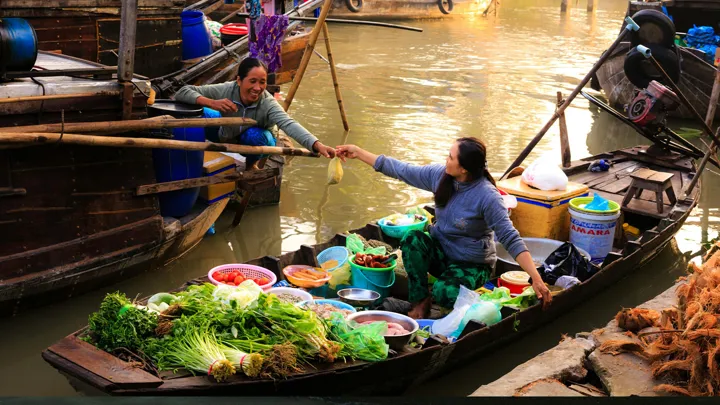
Option 1: 10 Days (Highlights)
Hanoi → Halong Bay → Hoi An → Ho Chi Minh City → Mekong Delta
Perfect for a first trip to Vietnam, this itinerary gathers the country’s most emblematic destinations into a smooth and well-paced journey.
Hanoi welcomes you with its charming Old Quarter, atmospheric temples and a deep dive into Vietnamese daily life.
From there, you continue to Halong Bay, where towering limestone pillars and emerald waters create one of Asia’s most breathtaking seascapes.
A flight south takes you to Hoi An, a beautifully preserved trading port known for lantern-lit streets, golden beaches and refined cuisine.
In Ho Chi Minh City, you experience Vietnam’s energetic modern face through bustling markets, historical landmarks and vibrant neighbourhoods.
The trip concludes in the Mekong Delta, a peaceful world of floating markets, tropical orchards and waterways where rural life unfolds at an unhurried rhythm.
This 10-day circuit is ideal for those who want to grasp the essence of Vietnam in a short time.
Option 2: 12 Days (Cultural Discovery)
Hanoi → Ninh Binh → Halong Bay → Hue → Hoi An → Saigon
Designed for travellers searching for a deeper cultural experience, this itinerary reveals Vietnam’s rich heritage through both iconic and lesser-known sites.
After exploring Hanoi, you journey to Ninh Binh, often called “Halong Bay on land” thanks to its dramatic karst mountains, ancient pagodas and tranquil river landscapes.
You then continue to Halong Bay for an overnight cruise among spectacular limestone formations.
A short flight brings you to Hue, the former imperial capital where citadels, royal tombs and poetic riverside scenery keep centuries of history alive.
As you reach Hoi An, you enjoy a gentle atmosphere, craft villages and charming riverside evenings illuminated by hundreds of lanterns.
The trip finishes in Saigon, where colonial heritage, Vietnamese street food and dynamic urban life create an unforgettable contrast.
This 12-day journey is perfect for travellers who appreciate history, architecture and a relaxed pace.
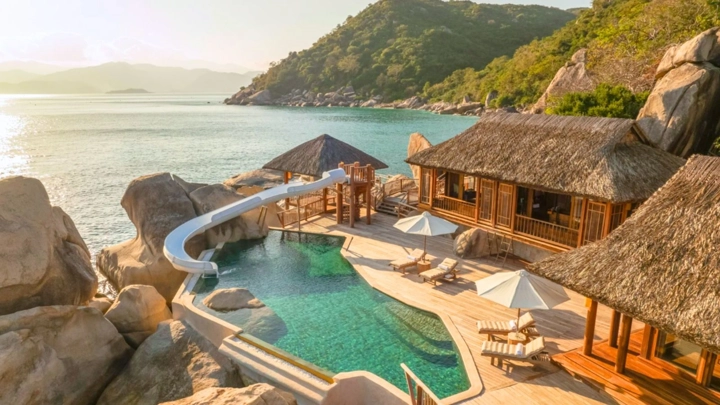
Option 3: 14–16 Days (Complete Vietnam)
Hanoi → Sapa → Halong Bay → Hue → Hoi An → Saigon → Mekong Delta → Phu Quoc
This extended itinerary is ideal for travellers wondering How to travel to Vietnam from Poland ? who want to explore the country in its full diversity mountains, coastline, cities, culture and tropical islands.
Begin in Hanoi, then travel to Sapa, where lush rice terraces, cool mountain air and encounters with ethnic minority communities offer some of Vietnam’s most authentic experiences.
Continue to Halong Bay for an unforgettable cruise surrounded by dramatic limestone karsts.
Head south to Hue to discover its Imperial City and majestic tombs before reaching Hoi An, a coastal haven of ancient architecture and culinary traditions.
In Saigon, immerse yourself in urban energy before venturing into the Mekong Delta to explore floating markets, canals and vibrant rural life.
Finally, unwind on the white-sand beaches of Phu Quoc, a tropical paradise perfect for swimming, snorkelling and relaxation after a long exploration.
A 14- to 16-day journey like this provides a complete and balanced overview of Vietnam, blending nature, history, culture and leisure.
7. Internal Transportation
Once you have settled the question How to travel to Vietnam from Poland?, the next essential step is understanding how to move efficiently inside the country. Vietnam offers several reliable modes of transportation, each suited to different travel styles and distances.
Domestic Flights
Domestic flights remain the fastest and most convenient solution for covering long distances, especially between the North, Centre and South. Major carriers such as Vietnam Airlines, VietJet Air, and Bamboo Airways operate frequent routes linking Hanoi, Da Nang, Ho Chi Minh City, and other regional airports. These airlines offer generally modern fleets, reasonable fares, and punctual services. For travellers with limited time or those wishing to avoid long road journeys, flying is often the most practical choice.

Trains
Travelling by train in Vietnam is a scenic and nostalgic way to experience the country. The famous Reunification Express runs from Hanoi to Ho Chi Minh City, offering a slow yet charming journey through rice fields, coastlines and villages. One of the most beloved sections is the Hanoi – Hue – Da Nang coastal route, where the train glides along cliffs overlooking the sea. Although slower than flying, trains provide a comfortable, atmospheric and authentic window into Vietnamese landscapes and daily life.
Buses & Limousines
Modern VIP buses and limousine vans are widely used, especially for medium-distance routes between major tourist destinations. These vehicles offer reclining seats, air-conditioning, and onboard amenities, making them a solid compromise between comfort and price. Popular routes include:
Sapa : for mountain adventures and ethnic villages
Ha Giang : gateway to the legendary loop and karst landscapes
Ninh Binh : often called “Ha Long Bay on land”
Ha Long : ideal for connections to the bay’s cruises
Departures are frequent, and schedules are well-organised, making this option convenient for travellers who prefer not to fly or drive.
Private Car with Driver
Hiring a private car with a dedicated driver offers maximum comfort and flexibility. It is especially suitable for:
Families who need space, safety and tailored stops
Elderly travellers seeking a smooth, stress-free journey
Photographers who require time and freedom to stop for landscapes
Off-the-beaten-path trips where public transport is limited or unavailable
This option allows you to travel at your own pace, reach remote areas, and enjoy personalised service throughout the journey.
By understanding these transportation options, travellers gain a clearer and more practical picture of How to travel to Vietnam from Poland?. Each method has its own advantages depending on your itinerary, comfort needs and travel style, ensuring that moving within Vietnam is as rewarding as reaching it.
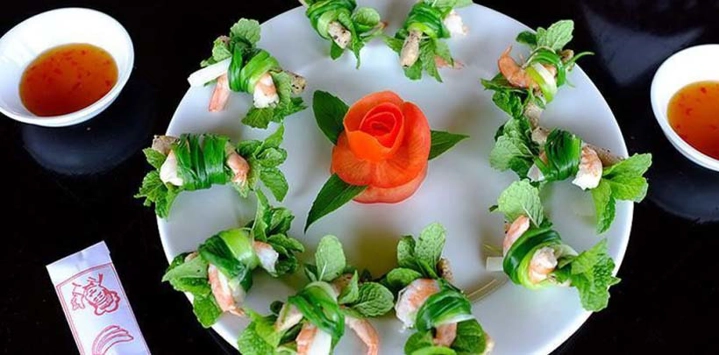
8. Where to Stay?
Vietnam offers an impressive diversity of accommodation, allowing every traveler to find a comfortable place that suits their expectations. When planning How to travel to Vietnam from Poland?, it helps to know what types of hotels you can expect, how much they cost, and which areas are best for an enjoyable stay :
Price Ranges
Vietnam's hotel pricing remains one of the most attractive in Asia, offering excellent value for money:
Boutique hotels (150–250 PLN)
Perfect for travelers who enjoy charming décor, personalized service, and a warm atmosphere. These small establishments often feature local architectural touches, stylish rooms, and a peaceful environment ideal for cultural trips.
4-star hotels (200–350 PLN)
A great balance between comfort and affordability. Expect spacious rooms, professional service, swimming pools, spas, and high-quality breakfasts. These hotels are ideal for families, couples, and travelers seeking convenience without overspending.
5-star luxury resorts (400–1000 PLN)
Designed for a premium experience, these resorts offer beachfront locations, private pools, elegant spas, and world-class hospitality. They are perfect for honeymoons, relaxation holidays, or anyone seeking high-end comfort during their journey.
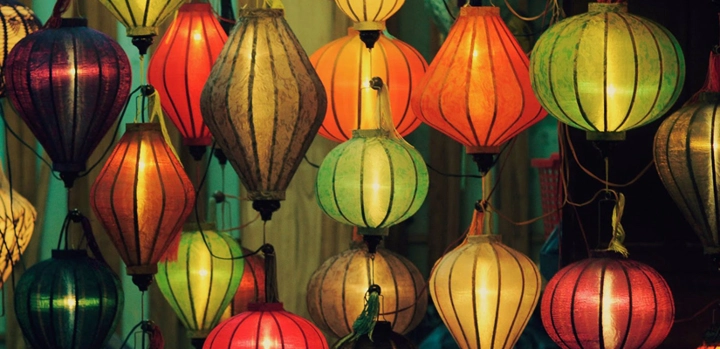
Recommended Areas
Hanoi Old Quarter
The heart of the capital, known for its narrow streets, traditional houses, street food stalls, and lively atmosphere. Staying here allows you to explore Hoan Kiem Lake, night markets, cafés, and cultural sites within walking distance.
Hoi An Ancient Town
A UNESCO World Heritage site famous for lantern-lit streets, riverside cafés, tailor shops, and traditional wooden houses. The atmosphere is peaceful and romantic, making it ideal for couples and culture lovers.
Hue Riverside
Overlooking the Perfume River, this area offers a calm environment close to the Imperial City, royal tombs, and pagodas. Perfect for travelers interested in history, architecture, and serene landscapes.
Saigon District 1
The modern and energetic center of Ho Chi Minh City, full of restaurants, museums, rooftop bars, and shopping streets. It is the most convenient area for first-time visitors who want everything within quick reach.
Phu Quoc – Long Beach or Ong Lang
These coastal areas offer stunning sunsets, soft sandy beaches, and a wide range of resorts. Long Beach is lively and convenient, while Ong Lang is quieter and more suitable for relaxation.
Vietnamese hospitality is often described as warm, sincere, and attentive. Staff members in hotels go out of their way to make guests feel welcome, offering thoughtful service and genuine smiles. Whether you choose a simple boutique hotel or a luxury resort, the kindness of the people often becomes one of the most memorable aspects of the trip.
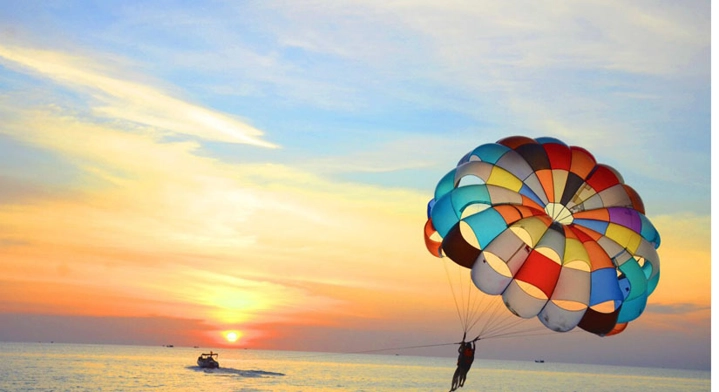
9. Budget Overview for Polish Travellers
Understanding How to travel to Vietnam from Poland ? starts with getting a clear idea of the daily costs you can expect on the ground. Vietnam remains one of the most affordable destinations in Asia, offering excellent comfort and memorable experiences without breaking the bank..
Average Daily Budget
Backpacker (120–170 PLN/day)
Ideal for travellers who enjoy simple guesthouses, street food and local buses. With this budget, you can still afford authentic meals, intercity buses, and visits to major attractions while keeping expenses low.
Comfort Traveller (200–350 PLN/day)
A balanced option for most visitors. This range covers comfortable 3–4★ hotels, domestic flights at promotional rates, guided day trips, and meals in mid-range restaurants. It allows you to enjoy a smooth travel experience without unnecessary expenses.
Luxury Traveller (450–1000+ PLN/day)
Perfect for those looking for premium hotels, boutique resorts, private drivers, fine-dining restaurants or cruise experiences in places such as Ha Long Bay. Vietnam offers exceptional luxury at prices still far below Western standards.
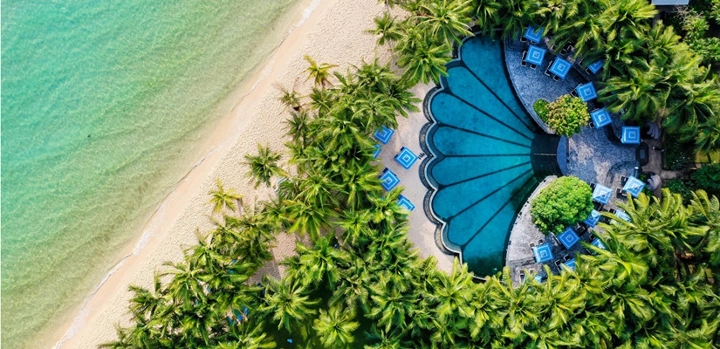
Typical Prices
Street food meal: 8–15 PLN
Fresh, flavourful and deeply rooted in local culture. Dishes like pho, banh mi or bun cha are filling while remaining incredibly economical.
Restaurant meal: 20–40 PLN
Ideal for travellers seeking a wider choice and better comfort. Many restaurants offer excellent menus combining Vietnamese classics and modern cuisine.
Coffee: 5–10 PLN
Vietnam is one of the world’s top coffee producers. Whether it’s an iced coconut coffee or a traditional drip brew, prices stay extremely affordable.
Taxi/Grab: 4–10 PLN for short distances
Grab (Asia’s equivalent of Uber) and taxis make city travel easy and inexpensive. Prices vary depending on traffic and distance but remain very accessible.
Tickets: 10–40 PLN
Entrance fees for museums, temples, caves or historical sites are generally low. Even well-known attractions rarely exceed this range.
Compared to European standards, Vietnam offers outstanding value for money: affordable accommodation, low-cost transportation and delicious cuisine at unbeatable prices. This makes it an ideal destination for Polish travellers looking to maximise both experience and budget.
10. Cultural Etiquette & Travel Tips
Respecting local customs is an essential part of How to travel to Vietnam from Poland ? and will help you build warm connections with the people you meet. Vietnam is a country where traditions guide daily life, and small gestures of courtesy can make your trip smoother and more meaningful. Observing cultural etiquette not only shows respect but also enriches your travel experience, especially when interacting with families, artisans, or local communities in rural areas.
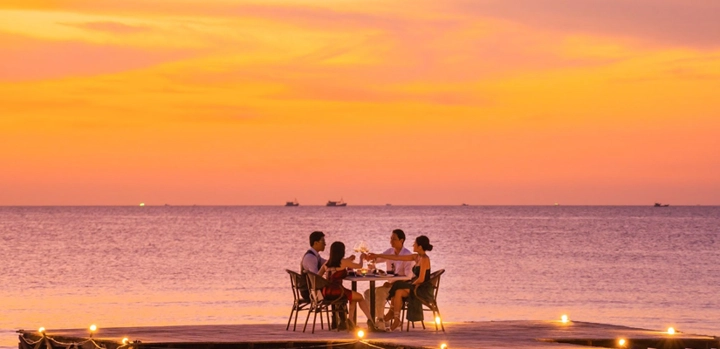
Important Tips
Dress modestly when visiting temples
Sacred places in Vietnam demand simple and respectful attire. Cover your shoulders, knees, and avoid overly tight or transparent clothing. This shows reverence for the spiritual environment and is appreciated by both monks and local worshippers.
Remove shoes before entering homes or pagodas
Taking off your shoes is a sign of cleanliness and respect. Whether you’re stepping into someone’s house, a traditional wooden home, or an ancient pagoda, always look for cues such as other people’s shoes at the entrance.
Avoid loud public conversations
Vietnamese society values harmony. Speaking loudly in buses, trains, cafés, or temples can be perceived as disruptive. Keeping a gentle tone helps you blend in and shows politeness toward those around you.
Always smile
A sincere smile is one of the most effective ways to communicate in Vietnam. Even when language is a barrier, a smile expresses kindness, builds trust, and often leads to warmer exchanges with locals.
Bargain politely in markets
Negotiating is part of daily life in Vietnam, especially in traditional markets. Keep the tone friendly, smile, and remember that bargaining is a conversation, not a confrontation. A courteous attitude often results in better prices.

Learn a few Vietnamese phrases
Even simple words like Chào (hello) or Cảm ơn (thank you) show your interest in the culture. Locals appreciate the effort, and this small gesture can immediately break the ice and create memorable moments.
Safety Tips
Vietnam is considered one of the safest destinations in Asia, but adopting a few basic precautions keeps your journey stress-free.
Keep your belongings close in crowded places
Busy areas such as night markets, festivals, and bus stations attract pickpockets. Use a crossbody bag, keep your phone secure, and stay aware of your surroundings.
Use registered taxis or Grab
Choose reliable transport options to avoid scams or inflated prices. Grab is widely available in big cities, easy to use, and offers transparent fares. Reputable taxi companies such as Mai Linh or Vinasun are also safe choices.
Drink bottled water
Tap water in Vietnam is not drinkable. Always choose sealed bottled water, and avoid ice in rural areas unless you are sure it is purified. This simple precaution helps you avoid digestive issues during your trip.

11. Essential Items to Pack
When preparing How to travel to Vietnam from Poland ?, travellers should bring light clothing + one warm layer, comfortable walking shoes, rain jacket (for tropical showers), sunscreen, power adapter type A/C, mosquito repellent, copies of passport & visa.
Packing efficiently contributes to a smooth trip because it allows you to stay organised, avoid unnecessary stress, and enjoy every moment of your journey. When your luggage is thoughtfully prepared, you save time at airports, move more easily from one destination to another, and always have what you need at hand. Efficient packing also means carrying only what is truly essential, which makes your bag lighter and your itinerary more flexible.
Good preparation starts with understanding your destination: its climate, cultural norms, planned activities, and potential challenges. This knowledge helps you select the right clothes, gear, and accessories without overpacking. By using smart packing techniques such as rolling clothes, using compression bags, and placing heavier items near the wheels you maximise space and maintain a clean, structured suitcase.
Efficient packing also enhances safety and comfort. With a well-organised bag, valuables are easy to secure, liquids are properly stored, and important documents remain accessible throughout the trip. It reduces the risk of losing items and allows you to adapt quickly in case of flight changes, delays, or unexpected weather.
Most importantly, efficient packing gives you peace of mind. Instead of worrying about missing essentials, you can focus entirely on discovering new destinations, meeting people, and creating meaningful travel memories. It is a simple but powerful step toward a smoother, more enjoyable journey.
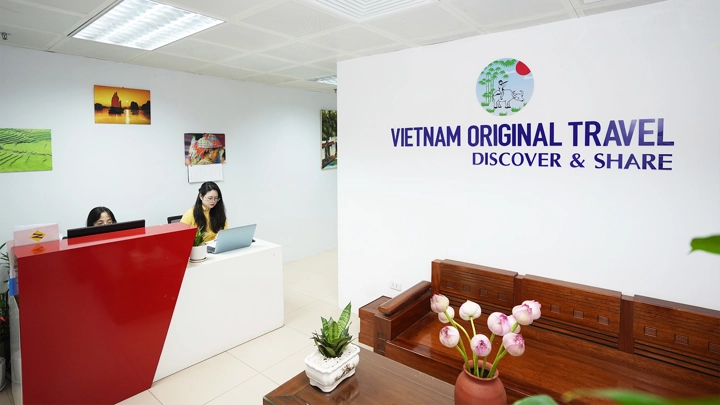
12. Why Travel with a Local Agency?
Travelling with a reputable Vietnamese DMC is the smartest choice for anyone wondering How to travel to Vietnam from Poland? A local partner offers not only expertise but also a level of reassurance and flexibility that international agencies simply cannot match. Here is what you gain :
With a local agency, assistance is available around the clock, wherever you are in Vietnam. Whether you need help adjusting your itinerary due to weather, clarifying transport arrangements, or solving a last-minute issue at your hotel, a dedicated team is always on the ground and ready to respond instantly. This real-time support ensures a smooth, stress-free journey from the moment you land.
A local DMC understands the country intimately its culture, seasons, distances, and hidden gems. Your itinerary is crafted around your interests and travel rhythm, whether you prefer nature, culture, adventure, gastronomy, or a mix of everything. Each experience is designed to feel personal, meaningful, and coherent, rather than a generic tour copied from a brochure.
Local agencies work directly with trusted hotels, boutique lodges, eco-friendly homestays, and high-quality cruise companies in Ha Long Bay, the Mekong, or Lan Ha. Thanks to long-term partnerships, they secure preferred rates, priority availability during peak season, and better room categories advantages rarely accessible to travellers booking on their own.
Professional services in English, French, Spanish, Italian, and German (upon request) make communication easy and transparent. Whether you need guidance during your trip, a bilingual guide, or assistance handling formalities, you benefit from a team that speaks your language and understands your expectations.
A reliable local agency promotes experiences that respect local communities and the environment. You can explore ethnic villages with trained local guides, join meaningful cultural encounters, enjoy farm-to-table meals, or stay in family-run homestays that preserve traditions. Travelling responsibly ensures your visit has a positive impact while giving you a deeper, more genuine understanding of Vietnam.
Choosing a trustworthy local DMC means you travel with confidence. You know that every detail—transfers, hotels, guides, permits, meals, domestic flights—has been carefully arranged by experts who live and operate in the destination. From the first planning steps to your return flight home, you are supported by professionals who take your safety and comfort seriously.
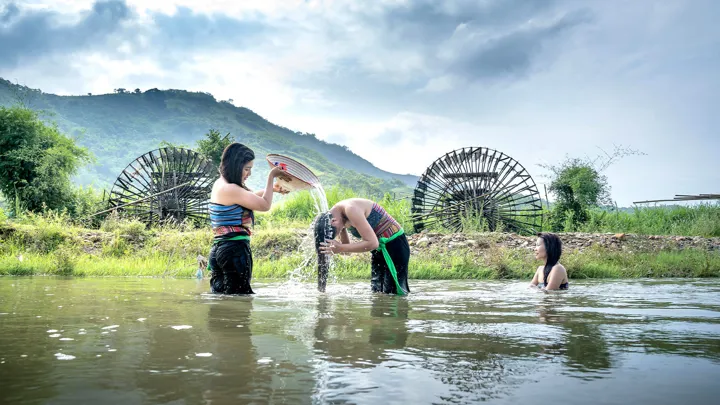
Your Complete Answer to How to Travel to Vietnam from Poland ?
Traveling from Poland to Vietnam is a journey full of contrasts, emotions and unforgettable discoveries. From flight connections and visa requirements to ideal travel seasons, recommended itineraries and cultural etiquette, every aspect contributes to defining How to travel to Vietnam from Poland ? smoothly and confidently. Vietnam welcomes Polish travellers with open arms with its ancient traditions, breathtaking landscapes, delicious cuisine and its gentle way of life that captivates every visitor.
What you need to know too:
Send us your comments about : How to Travel to Vietnam from Poland : The Complete, Practical & Inspiring Guide
Required fields *
You might also be interested
Travel ideas
Need some inspiration? Discover some of the best tours in Vietnam, which are highly appreciated by our clients. An excellent starting point to help you choose the right trip to Vietnam, Laos, Cambodia, Burma or Thailand, whether you are traveling alone, as a couple, as a family or with friends.
And because this trip is yours, feel free to customize it as you wish!
Vietnam Cambodia Itinerary 14 Days
Hanoi – Hoa Binh – Mai Chau – Ninh Binh – Halong bay – Hue - Danang – Hoian – Saigon – Ben Tre - Can Tho – Saigon - Siem Reap Angkor - Tonlé Sap - Siem Reap – Ta Prohm - Departure
Vietnam 14 Day Itinerary
Vietnam 14-day itinerary covers the country’s top highlights and quintessential experiences for an unforgettable journey.
Honeymoon Tour Pakcages In Vietnam 12 Days
Saigon Arrival - City Tour – Mekong Delta – Danang – Hoian - by flight - Da Nang – Hanoi - by flight – Halong - overnight on junk – Departure
Authentic Hoang Su Phi Trekking Tours
Hoang Su Phi trekking tours take you to stunning terraces, meet few tourists, connect with locals and enjoy authentic culture.
Best Nha Trang Beach Tour 4 Days
Saigon/Hanoi – Nha Trang relaxation – Saigon/Hanoi – Departure
Mekong Delta Bike Tour Itinerary 7 Days
Cycle through the Mekong Delta in 7 days, discovering floating markets, orchards, craft villages, and tranquil green islands.
Are you interested in this tour?










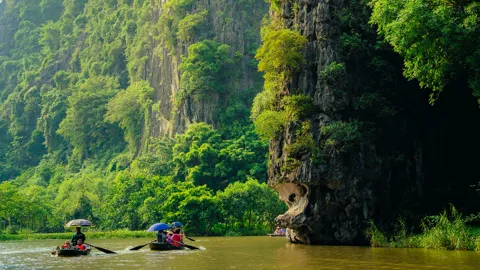






















Comment